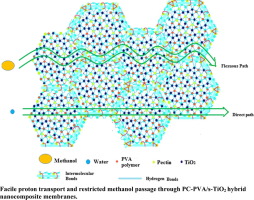当前位置:
X-MOL 学术
›
Arab. J. Chem.
›
论文详情
Our official English website, www.x-mol.net, welcomes your
feedback! (Note: you will need to create a separate account there.)
Pectin based nanocomposite membranes as green electrolytes for direct methanol fuel cells
Arabian Journal of Chemistry ( IF 5.3 ) Pub Date : 2020-01-01 , DOI: 10.1016/j.arabjc.2018.03.001 S. Mohanapriya , G. Rambabu , S.D. Bhat , V. Raj
Arabian Journal of Chemistry ( IF 5.3 ) Pub Date : 2020-01-01 , DOI: 10.1016/j.arabjc.2018.03.001 S. Mohanapriya , G. Rambabu , S.D. Bhat , V. Raj

|
Abstract Biocomposite materials are highly attractive for research and industrial application due to biodegradability, nontoxicity and sustainability. Solid electrolyte membrane derived from biodegradable materials broadens scope of using sustainable polymers and is easily disposable at the end of life cycle. In this study, Pectin (PC) is blended with polyvinyl alcohol (PVA) in order to fabricate new class of hybrid nanocomposite followed by addition of sulfonated titanium dioxide (s-TiO 2 ) nanoparticles as inorganic proton conducting material. PVA and PC is in situ cross-linked using dual cross-linker comprising a mixture of sulfosuccinic acid and glutaraldehyde followed by solvent casting. Rheological studies with polymer solutions are conducted to study alignment and disentanglement of polymer chains at molecular level. It is shown that rational design of membrane microstructure with proper arrangement of hydrophobic/hydrophilic domains has been formulated by blending PVA with PC. PC-PVA blends with a flexible polymeric network which is appropriate to disperse rigid s-TiO 2 nanoparticles resulting in improved proton conductivity and restricted methanol permeability. With further enriched proton conductivity by the presence of s-TiO 2 nanoparticles, fabricated PC-PVA/s-TiO 2 hybrid nanocomposite membrane exhibit a peakpower density of 27 mW/cm 2 at 70 °C in DMFCs.
中文翻译:

果胶基纳米复合膜作为直接甲醇燃料电池的绿色电解质
摘要 生物复合材料由于可生物降解、无毒和可持续性,在研究和工业应用中极具吸引力。源自可生物降解材料的固体电解质膜拓宽了可持续聚合物的使用范围,并且在生命周期结束时易于丢弃。在这项研究中,将果胶 (PC) 与聚乙烯醇 (PVA) 混合以制造新型混合纳米复合材料,然后添加磺化二氧化钛 (s-TiO 2 ) 纳米颗粒作为无机质子传导材料。PVA 和 PC 使用包含磺基琥珀酸和戊二醛混合物的双交联剂进行原位交联,然后进行溶剂浇铸。使用聚合物溶液进行流变学研究,以在分子水平上研究聚合物链的排列和解缠结。结果表明,通过将 PVA 与 PC 混合,可以合理设计具有适当排列的疏水/亲水区域的膜微结构。PC-PVA 与柔性聚合物网络混合,适合分散刚性 s-TiO 2 纳米粒子,从而提高质子传导性并限制甲醇渗透性。由于 s-TiO 2 纳米颗粒的存在,进一步增强了质子传导性,制造的 PC-PVA/s-TiO 2 混合纳米复合膜在 DMFC 中在 70°C 下表现出 27 mW/cm 2 的峰值功率密度。PC-PVA 与柔性聚合物网络混合,适合分散刚性 s-TiO 2 纳米颗粒,从而提高质子传导性并限制甲醇渗透性。由于 s-TiO 2 纳米颗粒的存在,进一步增强了质子传导性,制造的 PC-PVA/s-TiO 2 混合纳米复合膜在 DMFC 中在 70°C 下表现出 27 mW/cm 2 的峰值功率密度。PC-PVA 与柔性聚合物网络混合,适合分散刚性 s-TiO 2 纳米粒子,从而提高质子传导性并限制甲醇渗透性。由于 s-TiO 2 纳米颗粒的存在,进一步增强了质子传导性,制造的 PC-PVA/s-TiO 2 混合纳米复合膜在 DMFC 中在 70°C 下表现出 27 mW/cm 2 的峰值功率密度。
更新日期:2020-01-01
中文翻译:

果胶基纳米复合膜作为直接甲醇燃料电池的绿色电解质
摘要 生物复合材料由于可生物降解、无毒和可持续性,在研究和工业应用中极具吸引力。源自可生物降解材料的固体电解质膜拓宽了可持续聚合物的使用范围,并且在生命周期结束时易于丢弃。在这项研究中,将果胶 (PC) 与聚乙烯醇 (PVA) 混合以制造新型混合纳米复合材料,然后添加磺化二氧化钛 (s-TiO 2 ) 纳米颗粒作为无机质子传导材料。PVA 和 PC 使用包含磺基琥珀酸和戊二醛混合物的双交联剂进行原位交联,然后进行溶剂浇铸。使用聚合物溶液进行流变学研究,以在分子水平上研究聚合物链的排列和解缠结。结果表明,通过将 PVA 与 PC 混合,可以合理设计具有适当排列的疏水/亲水区域的膜微结构。PC-PVA 与柔性聚合物网络混合,适合分散刚性 s-TiO 2 纳米粒子,从而提高质子传导性并限制甲醇渗透性。由于 s-TiO 2 纳米颗粒的存在,进一步增强了质子传导性,制造的 PC-PVA/s-TiO 2 混合纳米复合膜在 DMFC 中在 70°C 下表现出 27 mW/cm 2 的峰值功率密度。PC-PVA 与柔性聚合物网络混合,适合分散刚性 s-TiO 2 纳米颗粒,从而提高质子传导性并限制甲醇渗透性。由于 s-TiO 2 纳米颗粒的存在,进一步增强了质子传导性,制造的 PC-PVA/s-TiO 2 混合纳米复合膜在 DMFC 中在 70°C 下表现出 27 mW/cm 2 的峰值功率密度。PC-PVA 与柔性聚合物网络混合,适合分散刚性 s-TiO 2 纳米粒子,从而提高质子传导性并限制甲醇渗透性。由于 s-TiO 2 纳米颗粒的存在,进一步增强了质子传导性,制造的 PC-PVA/s-TiO 2 混合纳米复合膜在 DMFC 中在 70°C 下表现出 27 mW/cm 2 的峰值功率密度。











































 京公网安备 11010802027423号
京公网安备 11010802027423号